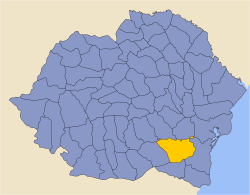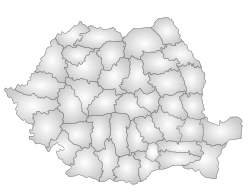Ialomiţa County
Demographics
In 2011, the county had a population of 258,669 and the population density was 58.08/km.
Romanians make up 95.6% of the population, the largest minority being the Romani people (4.1%).
| Year | County population |
|---|---|
| 1948 | 244,750 |
| 1956 | 274,655 |
| 1966 | 291,373 |
| 1977 | 295,965 |
| 1992 | 304,008 |
| 2002 | 296,572 |
| 2011 | 258,669 |
| 2021 | 250,816 |
Geography

Ialomița County has a total area of 4,453 km (1,719 sq mi). The county is situated in the Bărăgan Plain. The area is flat crossed by small rivers with small but deep valleys.
Its eastern border is on the Danube. The Ialomița River crosses the county from West to East about the middle. The Danube is split around the Ialomița Pond into the Old Danube branch and the Borcea branch.
Until 1940 (in the western part) and 1967 (in the eastern part) the county/plain was home of the great bustard (dropie in Romanian), with large populations of this bird. The birds disappeared because of the massive village buildout and hunting them for food.
Neighbours
- Constanța County in the East.
- Ilfov County in the West.
- Brăila County, Buzău County, and Prahova County in the North.
- Călărași County in the South.
Economy
Agriculture is the main occupation in the county. Industry is almost entirely concentrated in the city of Slobozia.
The predominant industries in the county are:
- Food industry.
- Textile industry.
- Mechanical components industry.
Tourism

The main tourist destinations are:
- The city of Slobozia.
Politics
The Ialomița County Council, renewed at the 2020 local elections, consists of 30 counsellors, with the following party composition:
| Party | Seats | Current County Council | ||||||||||||||
|---|---|---|---|---|---|---|---|---|---|---|---|---|---|---|---|---|
| Social Democratic Party (PSD) | 14 | |||||||||||||||
| National Liberal Party (PNL) | 10 | |||||||||||||||
| PRO Romania (PRO) | 6 | |||||||||||||||
Administrative divisions



Ialomița County has 3 municipalities, 4 towns and 59 communes.
- Municipalities
- Towns
- Communes
- Adâncata
- Albești
- Alexeni
- Andrășești
- Armășești
- Axintele
- Balaciu
- Bărcănești
- Bărbulești
- Borănești
- Bordușani
- Bucu
- Buești
- Ciocârlia
- Ciochina
- Ciulnița
- Cocora
- Colelia
- Cosâmbești
- Coșereni
- Drăgoești
- Dridu
- Făcăeni
- Gârbovi
- Gheorghe Doja
- Gheorghe Lazăr
- Giurgeni
- Grindu
- Grivița
- Gura Ialomiței
- Ion Roată
- Jilavele
- Maia
- Manasia
- Mărculești
- Mihail Kogălniceanu
- Miloșești
- Moldoveni
- Movila
- Movilița
- Munteni-Buzău
- Ograda
- Perieți
- Platonești
- Rădulești
- Reviga
- Roșiori
- Sălcioara
- Sărățeni
- Săveni
- Scânteia
- Sfântu Gheorghe
- Sinești
- Stelnica
- Sudiți
- Traian
- Valea Ciorii
- Valea Măcrișului
- Vlădeni
Historical county
Județul Ialomița | |
|---|---|
County (Județ) | |
 The Ialomița County prefecture building from the interwar period, now the prefecture building of Călărași County. | |
 | |
| Country | |
| Historic region | Muntenia |
| Capital city (Reședință de județ) | Călărași |
| Area | |
| • Total | 7,095 km (2,739 sq mi) |
| Population (1930) | |
| • Total | 293,352 |
| • Density | 41/km (110/sq mi) |
| Time zone | UTC+2 (EET) |
| • Summer (DST) | UTC+3 (EEST) |
Historically, the county was located in the southeastern part of Greater Romania, in the southeastern part of the historical region of Muntenia. The county comprised a large part of the current Ialomița County and of today's Călărași County. It was bordered to the west by Ilfov County, to the north by the counties of Prahova, Buzău and Brăila, to the east by Constanța County, and in the south by Durostor County.
With an area of 7,095 square kilometres (2,739 sq mi), Ialomița County was one of the largest counties of Greater Romania.
Administration

The county was originally divided administratively into five districts (plăși):
- Plasa Călărași, headquartered at Călărași
- Plasa Lehliu, headquartered at Lehliu
- Plasa Slobozia, headquartered at Slobozia
- Plasa Țăndărei, headquartered at Țăndărei
- Plasa Urziceni, headquartered at Urziceni
Subsequently, three new districts were added:
- Plasa Căzănești, headquartered at Căzănești
- Plasa Dragoș Vodă, headquartered at Dragoș Vodă
- Plasa Fetești, headquartered at Fetești
Population
According to the 1930 census data, the county population was 293,352 inhabitants, ethnically divided as follows: 96.6% Romanians, 2.5% Romanies, 0.2% Jews, as well as other minorities. From the religious point of view, the population was 99.3% Eastern Orthodox, 0.2% Jewish, 0.1% Roman Catholic, as well as other minorities.
Urban population
In 1930, the county's urban population was 34,260 inhabitants, comprising 90.2% Romanians, 6.0% Romnanies, 1.3% Jews, as well as other minorities. From the religious point of view, the urban population was composed of 97.4% Eastern Orthodox, 1.4% Jewish, 0.5% Roman Catholic, as well as other minorities.
References
- ^ "Populaţia rezidentă după grupa de vârstă, pe județe și municipii, orașe, comune, la 1 decembrie 2021" (XLS). National Institute of Statistics.
- ^ The number used depends on the numbering system employed by the phone companies on the market.
- ^ National Institute of Statistics, "Populația după etnie" Archived 2009-08-16 at the Wayback Machine
- ^ National Institute of Statistics, "Populația la recensămintele din anii 1948, 1956, 1966, 1977, 1992 și 2002" Archived 2006-09-22 at the Wayback Machine
- ^ "Rezultatele finale ale alegerilor locale din 2020" (Json) (in Romanian). Autoritatea Electorală Permanentă. Retrieved 2020-11-02.
- ^ Portretul României Interbelice - Județul Ialomița


